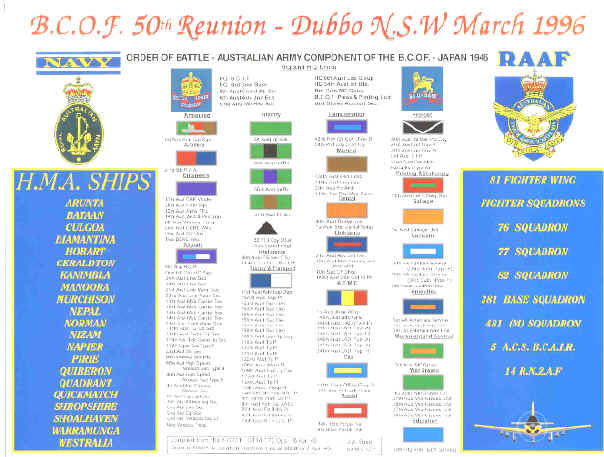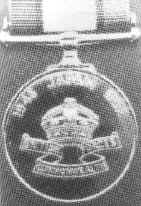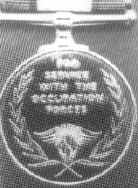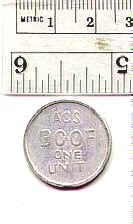|
THE OCCUPATION
FORCE IN JAPAN
In December 1945 it was
agreed by the United States Government that the Governments of the
United Kingdom, Australia, New Zealand and India should each
provide a national contingent for a force to participate in the
occupation of Japan.
The objects Of
this force, which was designated "British Commonwealth
Occupation Force" and known by the initial letters B.C.O.F.,
were:
(a) To represent
the British Commonwealth in the occupation of Japan and to
maintain and enhance British Commonwealth prestige in the eyes of
the Japanese and our Allies.
(b) To
demonstrate to the Japanese our democratic ways of life and living
standards.
Lieutenant-General
J. Northcott, C.B., M.V.O., was appointed Commander-in-Chief.
Each contingent
of the force had an Army and Air Force component. Army components
were provided as follows: a British-Indian Division known as
BRINDIV composed of 5 British Infantry Brigade Group and 268 Indian
Infantry Brigade Group; 34 Australian Infantry Brigade Group, and
9 New Zealand Infantry Brigade Group.
The Air Force component
comprised two R.A.F. squadrons, three R.A.A.F. squadrons, one R.N.Z.A.F. squadron
and one R.I.A.F. squadron. In addition there were shore-based
naval personnel supplied by the Royal Navy.
 |
Postage stamp,
worth 3 pennies (3 cents) and postmarked BCOF in 1946 |
Early in
February the main advance parties of H.Q. B.C.O.F., British
Command Base and 34 Australian Infantry Brigade reached Kure.
They came from
Morotai (where the Australian Army component had been
concentrated) on the Stamford Victory with 1122 troops. |
Eight days later
came the Taos Victory and two L.S.Ts from Morotai, H.M.S. Glengyle,
the River Murrumbidgee and three L.S.Ts from Labuan. On
the twenty-third the Pacbaug Victory berthed. From these
vessels 4000 troops were disembarked and with the exception of 753
of the R.A.A.F. they formed the main bodies of H.Q. B.C.O.F.,
British Command Base and 34 Australian Infantry Brigade.
In the meantime
Lieutenant-General Northcott had arrive at the Hiroshima airfield
and assumed command of the force.
On 1 March the Cheshire
and Saingara arrived from Singapore bringing the
advance parties of BRINDIV, 9 New Zealand Brigade and the R.A.F.
Vessels of all sizes continued to arrive until by the end of March
17,517 personnel, 2566 vehicles and 111,707 tons
of stores had been landed.
H.M.A.S. Manunda
anchored off the port on 21 March. She brought the main
body of personnel and stores for the 13o Australian General
Hospital. The hospital was receiving patients within a fortnight.
Kure, which had
been selected as the site of the first headquarters of B.C.O.F. in
Japan, is situated on the southern coast of the island of Honshu
on the Inland Sea. Since 1883 it has been the principal
naval base of Japan and the area included the largest combined
dockyard, ship-building yard and naval arsenal in the country.
The U.S. Air
Corps had given the port installations a terrific hammering. Huge
workshops, factories, shipyards, dry-docks, warehouses and other
buildings had been reduced to skeletons of twisted steel girders
and heaps of rubble. Kure as a naval base had been completely
ruined.
In the early
days of February and March the temperature did not rise more than
a few degrees above freezing point. H.Q. B.C.O.F. and H.Q. British
Command Base were established in what remained of Kure. At
Kaidaichi (about fourteen miles from Kure) 34 Australian
Infantry Brigade was quartered. The camp, which consisted of
wooden army huts, had previously been used by the Americans. The
settling-in period was arduous as there were no facilities for
heating and no floor coverings. H.Q. 9 New Zealand Brigade
was established at Chofu while H.Q. BRINDIV occupied barracks at
Hiro formerly used by the Americans.
The area of
occupation originally allotted to B.C.O.F. comprised the
Prefectures of Hiroshima and Yamaguchi; 34 Brigade occupied the
former and on 23 March the New Zealand Brigade took over the
latter. By this time BRINDIV had been brought up to full strength
and was encamped near Hiro.
On 15 March
BRINDIV occupied the Prefecture of Shimane and in the ensuing
weeks took over from 24 U.S. Division the Prefectures of Tottori
and Okayama and the island of Shikoku. This brought the area
occupied by B.C.O.F. up to 19,610 square miles with a population
of 9,055,000.
H.Q. BRINDIV was
transferred to Okayama and 34 Australian Brigade moved into the
site previously occupied by BRINDIV at Hiro.
Flag marches and
parades have been held in most of the cities and larger towns in
the occupation area with a view to impressing, if possible, the
Japanese.
On 12 April the
flags of all the nations included in the force were broken from a
high signal tower overlooking the harbour of Kure. A
representative guard of honour received the C-in-C, with a general
salute played by the band of the Kumaon Regiment.
Anzac Day was
commemorated in Japan for the first time, when soldiers, sailors
and airmen of B.C.O.F. gathered at Kure. The Commander-in-Chief,
Lieutenant-General J. Northcott
himself
an original Anzac, took the
salute from the marching troops and from aircraft in a spectacular
fly-past.
During-May, H.Q.
B.C.O.F. was moved to the island of Eta Jima in Kure Bay,
about five miles west of the town, the buildings used being those
which had previously been the Japanese Naval Academy .There are
several magnificent buildings which are now being used by HQ, BCOF
as offices, quarters, messes, theatre, education centre, church
and also by 130 Australian General hospital.
On 16 June
command of the force passed to Lieutenant-General H. C. H.
Robertson, C.B.E., D.S.O., and on 24 June Lieutenant General
Northcott left for Australia to take up his appointment as
Governor of New South Wales.
The major task
of the force has been the destruction of the Japanese war machine.
A vast quantity of enemy equipment and warlike stores of all kinds
exists in the B.C.O.F. area. The location, assessment and final
disposal of this material presents a difficult problem. A new
section of the General Staff Branch known as the Disposal of Enemy
Equipment Section-was formed to undertake the organization
necessary.
At first routine
patrolling and searching by formations were carried out on a local
basis, but now a co-ordinated plan for the systematic searching of
the whole area is in operation. Enemy equipment is disposed of by
providing material for the occupation troops, by destruction or by
handing over to the Japanese Home Ministry any items which can be
used in the rehabilitation of Japanese industry and civilian life.
The whole of the
B.C.O.F. area was found to be honeycombed with caves and tunnels
storing material and it is estimated that there are some thousands
of targets remaining to be dealt with. Many of these contain large
quantities of explosives, ammunition and poison gases. In addition
to the troops engaged in this work, Japanese labour, including
technicians, is also employed.
The surveillance
of the Japanese elections, held on 10 April, was another important
duty undertaken by the force. For a week prior to polling day
observer teams operated throughout the B.C.O.F. area, which then
comprised the Prefectures of Hiroshima, Shimane and Yamaguchi, to
ensure that there was no coercion and that the election was
conducted in a fair, free and democratic manner in accordance with
the Supreme Commander of Allied Powers' orders. In spite of
vigorous campaigning by all parties there were no incidents of a
serious nature.
In the B.C.O.F.
area there are three repatriation centres which handle incoming
Japanese nationals and outgoing repatriates of other
nationalities, mostly Koreans, Formosans and Ryukyuans. The
Japanese Government is responsible for the administration and work
of the centres which include reception, processing, feeding,
housing and dispatch of the repatriates. The centres at Senzaki
and Otake are supervised by 9 New Zealand Infantry Brigade and the
centre at Ujina by 34 Australian Infantry Brigade.
Since January
more than half a million Japanese have passed through these
centres and since April more than fourteen thousand Koreans and
Formosans have been returned to their homelands.
The Air Force
component of B.C.O.F. (known
as BCAIR) has its headquarters at Iwakuni with subordinate
commands at Bofu and Milio. There are serviceable airfields at all
three places. Aircraft carriers H.M.Ss Glory and Vengeance were
used to bring in some of the aircraft while the remainder were
flown in -including S i Fighter Wing (R.A.A.F.).
The principal
duties performed are surveillance patrols over the whole of the
B.C.O.F. area, prevention of smuggling of goods and illegal entry
(in conjunction with ground and naval forces) and the compilation
of meteorological forecasts based on reports received from various
stations. Air Officer Commanding is Air Vice-Marshal C.A.
Bouchier, C.B., CBE., DFC
The naval
component of B.C.O.F. was
formed from shore parties which had been organized and assembled
in the East Indies complete with stores and equipment for
projected landing operations in the South-east Asia Command.
Planning was
difficult on account of the scarcity of information from Japan and
the fact that time did not permit reconnaissance parties to be
sent in. However, arrangements were made for the British Pacific
Fleet to supply personnel, ships, harbour craft and motor
transport, and the loading of equipment was commenced.
By the end of 1945
requirements had become firmer and the B.C.O.F. area of
responsibility had been settled in so far as the port of entry was
concerned.
The force
concentrated in Colombo and, early in January, moved off via
Singapore and Hong Kong. While at the latter port the force
learned that i February had been set down as the date for the
arrival of the naval port party in Kure. This allowed it to remain
a week in Hong Kong getting acquainted with and in looking over
the boats and motor transport provided from Australia.
The force was
designated Force "C", with Captain J. A. Grindle,
C.B., RN, in command. The advance party arrived at Kure on 1
February 1946 as the first unit of B.C.O.F. and on 18
February the operation of the port was officially taken over from
the U.S. naval authorities. From then on the work of landing the
troops and stores of B.C.O.F. continued without serious delay or
difficulties. By the end of February all U.S. naval units had been
withdrawn.
Two months later
the whole of B.C.O.F. was in Japan and it was found possible to
make progressive reductions in Force "C". On 3 June
the shore-based party was recommissioned as H.M.S. Commonwealth
and it is by that old and proud ship name that the naval
element of B.C.O.F. is now known.
The principal
tasks have been the inspection and report of all Japanese naval
vessels sunk, beached or damaged in ports in the area of B.C.O.F.
responsibility, the clearance of wrecks, jetties and basins, and
the adjustment of the harbour facilities to meet occupation
requirements, the destruction of twenty-four Japanese submarines
in accordance with Allied-Japanese armistice terms and the
refuelling and operation of repatriation vessels in the Kure-Hiroshima area. |







